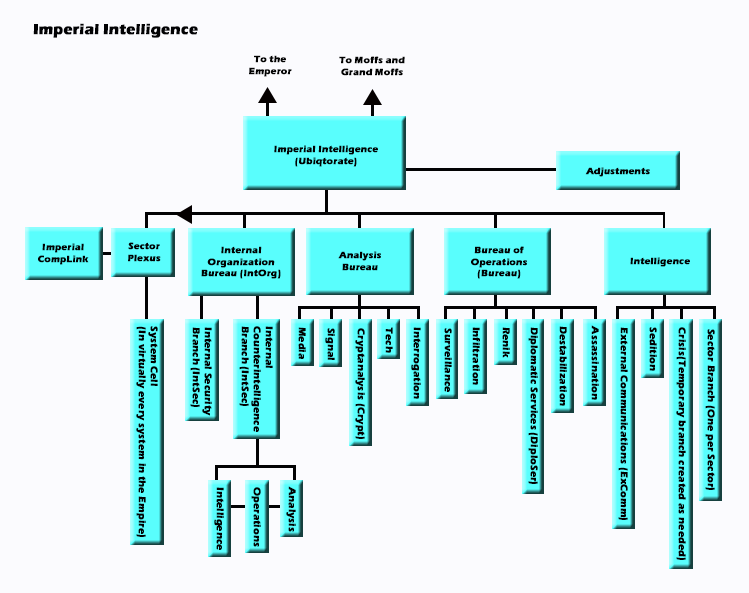Imperial Intelligence is one of the few New Order organizations which has remained largely unchanged since the days of the Old Republic. There were four organizations which gathered and analyzed intelligence for the Senate and other agencies of the Old Republic—the Republican Security Organization, the Senate Bureau of Intelligence, the Interstellar Consortium on Technology, and the euphemistically labeled Special Acquisitions Branch of the Library of the Republic.
As the Old Republic began to rot from within, the directors of the four agencies discovered that they were routinely being used by unscrupulous Senators who bribed lower level functionaries within the agencies to pass along misinformation through agency channels, in order to influence important intelligence reports which were presented to the Senate. The Senators’ greed caught up with them; they often were too cheap to bribe operatives of all four agencies, relying on the innate distrust of the intelligence agencies toward each other to prevent them from comparing scandocs.
A number of directors met during the last days of the struggle for the Senate. The negotiations were unprecedented in their openness and willingness to compromise personal power in order to maintain an effective intelligence organization for the government. But which government? The directors felt the Republic to be unsalvageable. In their opinion, the rot had gone too far, and there were too many constituent worlds to install an effective new government based on elected representation. A strong central government was needed — exactly the sort of government which Palpatine and his New Order promised.
Next they agreed to quietly and unofficially merge their four organizations. Information would be shared and compared among the branches of the organizations in order to decrease the odds that the information was “contaminated.” To oversee this process and the new intelligence organization, the Ubiqtorate was created. This was a governing body for all parts of the organization.
Once Palpatine was in power and the Empire was formed, the Ubiqtorate could operate with the Emperor’s blessing, and the pretense of four distinct organizations was discarded. Imperial Intelligence was born.
There are indications that the efficiency, professionalism, and speed with which Imperial Intelligence was reorganized frightened some of the Emperor’s advisors, quite a few of whom had used the Republican versions as they wished. Imperial Intelligence believes the flawless transition and expansion of capabilities are the reasons the advisors — through Crueya Vandron — created COMPNOR and the ISB.
The Ubiqtorate considers COMPNOR (especially the ISB) to be, at best, a misuse of valuable resources. At worst, COMPNOR is a case of arming and authorizing talented but untested amateurs to defend the Empire, the entire basis of their strategies and tactics being a few holos of political aphorisms on the New Order. Imperial Intelligence has cautiously presented evidence to the Moffs and Grand Moffs to whom they report, as well as the Emperor himself, that COMPNOR has often incited as much rebellion as COMPNOR has been able to squelch. The Grand Moffs are the only ones who give this information a positive reception, and even then it is mild. Imperial Intelligence is therefore resolutely determined to do the whole job themselves, even if it means cleaning up “the muck left behind by COMPNOR.”

Ubiqtorate
On many worlds, “Ubiqtorate” has come to be the name for the whole of Imperial Intelligence. The name came to light in several COMPNOR scandocs which were accidentally transmitted to a media beamcast in the Qeimat system. The scandocs themselves indicated that the authors were not aware of the real role of the Ubiqtorate, and Imperial Intelligence saw no reason to correct their error. From the beamcast the name caught on, as the Ubiqtorate sounded more mysterious, omnipresent and threatening than “Imperial Intelligence.”
The Ubiqtorate oversees all of the activities of Imperial Intelligence at the highest levels. Details and tactical considerations are decided by the appropriate bureau or branch of Imperial Intelligence. The Ubiqtorate never concerns itself with those. The Ubiqtorate formulates strategies for the bureaus of Imperial Intelligence or, as has recently become common, presents the bureaus with a set of goals and very broad grand strategic considerations and asks them to plan an effective strategy. With the exception of Adjustments, members of the Ubiqtorate never have any communication with personnel at the sector or system level. They would certainly never deal with an individual field agent.
The members of the Ubiqtorate are anonymous. They are unknown to their subordinates; a member of the Ubiqtorate is likely to be acquainted with the identities of perhaps a third of the members, and to have personal contact with only a handful. When communicating to the rest of Imperial Intelligence, the members of the Ubiqtorate identify the originator as “Ubiqtorate,” never an individual. This practice has been imitated by other organizations, most notably the Select Committee of COMPNOR.
Created through a compromise, the Ubiqtorate has become an organization of surprising thoroughness and effectiveness. It continues to improve.
Adjustments
Adjustments is the most elite branch of Imperial Intelligence. It consists of agents who receive their orders directly and in person from the Ubiqtorate. No record of their orders is ever kept, and no mission files exist within Sector Plexus for these agents.
Whenever the Ubiqtorate feels a critical situation has slipped from the control of Imperial Intelligence, and that the situation is beyond the normal capabilities of the bureaus but not yet completely hopeless, Adjustments is called in to restore order. The Ubiqtorate briefs the Adjustment agent or team on the problem and what resources are available to solve it. Adjustments then solves the problem.
Internal Organization Bureau (IntOrg)
Called “IntOrg” by those within Imperial Intelligence, this bureau’s mandate is to protect Imperial Intelligence’s security from outside threats and those which might be generated from within. As IntOrg must deal with the rest of Imperial Intelligence, its agents have cultivated a highly civil manner and a strong sense of political etiquette, and then combined those with complete ruthlessness when the stakes are high and the threat is real.
IntOrg is committed to the security of Imperial Intelligence, but rarely abuses its authority or conducts political witch-hunts. As a result, IntOrg enjoys a good reputation among the agents of other bureaus.
Internal Security Branch (IntSec)
Internal Security Branch (IntSec) is responsible for the physical security of the personnel, materiel and facilities of Imperial Intelligence. Originally considered a branch for the unambitious (especially by members of IntCon), IntSec has upgraded its personnel and procedures in response to bolder attacks by forces of the Rebellion. Their abilities have improved faster than their image; there is still a huge body of IntSec jokes making the rounds of the bureaus and branches.
IntSec officers are the only Imperial Intelligence personnel to obviously carry weapons while within intelligence facilities. They have a great many plainclothes agents who will operate outside the facilities, trying to spot and stop potential trouble before it is realized.
Internal Counter-intelligence Bureau (IntCon)
Internal Counterintelligence Branch (IntCon) looks for enemy agents or spy rings which may have been implanted in Imperial Intelligence by the Rebellion or other forces inimical to the New Order. Through Sector Plexus, they have an extraordinary freedom to access any data they may consider useful, in many cases obtaining the information more readily than would a member of the Ubiqtorate. IntCon deals with all levels of Imperial Intelligence, but recently they have begun to devote a greater proportion of their resources to personnel at the bureau level of Imperial Intelligence.
IntCon almost resembles Imperial Intelligence in miniature, with its own sections for Analysis, Operations and Intelligence. The boundaries between these sections often blur, and IntOrg is renown for its loose structure and the informal environment in which its agents work. Information inside IntOrg is heavily secured against access by parties outside IntOrg, but there is literally no information security from other members of IntOrg. This openness is how IntOrg monitors itself — every decision, action, or piece of data generated by a member of IntOrg is available to any other member of IntOrg who chooses to examine it. This lack of secrecy, and often privacy, makes it almost impossible for an enemy spy to operate within IntCon.
Analysis Bureau
This bureau handles gargantuan amounts of data from tens of millions of sources. In addition to looking for enemy activity, it looks for patterns or trends in social data which might be useful to the agents over in Intelligence. Analysis also handles, examines and copies useful technologies, even developing a few of their own.
Media
Media branch pores over public scandocs, newsdocs, holos, comlinks, beamcasts, every form of media in the Empire, looking for patterns or hidden meanings which might betray a clue as to an enemy’s plans and operations. Media can, with substantial assistance from Sector Plexus and the Imperial CompLink, give at least a cursory examination of all media in the Empire simultaneously. While they regularly concentrate on a significantly smaller portion of the Empire, they do cast their net wide often enough to make a professional judgment as to whether or not a new media source should be monitored on a more regular basis.

Signal
Signal has a saying: “Media examines every media message in the galaxy. We handle everything else so they can have the easy stuff.” This is probably an exaggeration, but the job done by Signal is indeed enormous. While Media monitors the intended message, Signal examines the channel through which the information was transmitted.
Signal samples and checks carrierwave codes and CompLink protocols, scan rates on scandocs and imagepacks on holos to see if any information is being squeezed into the space between what a citizen would ordinarily sense. Signal examines line noise to see if it might contain a pattern rather than random error. Broadcasts and beamcasts are examined to see if the backup information sent with the primary information actually matches and, if not, how they differ.
The agents in Media sarcastically refer to Signal as “a group of beings who sort through the garbage in order to discover what a family said to each other at breakfast.” Signal does occasionally overreach itself, applying blindingly sophisticated mathematical techniques to squeeze nonexistent meanings from chaotic data. However, it was Signal which discovered that Leia Organa had the plans to the Death Star through the analysis of un-shielded ELEL (Extremely Low Energy Level) transmissions from her ship.
Cryptanalysis (Crypt)
When Media or Signal finds evidence of coded communication, they give it to the Crypt. Those who work in Cryptanalysis call themselves “lignyots.” Why they call themselves lignyots, and if the word has any meaning independent of Cryptanalysis, is not known by anyone in the other branches. This is as intended.
Lignyots have gone out of their way to create a bizarre reputation for Crypt. They have sent scandocs to other branches in simple codes, which mutate into an unflattering holo if not broken quickly enough. They try to break the security of the communications between branches, forging inflammatory messages on a secure channel when they succeed.
They will often move the entrance to their offices or relocate their facilities entirely, leaving only a puzzling scandoc as to their new location. All communications to the Sector Plexus from the new branch office have invariably been relayed through thousands of points before reaching Sector Plexus, making successful tracing almost impossible.
The bureaus have complained to the Ubiqtorate about the unprofessional behavior of Crypt. Lignyots have always defended themselves by saying the relentless, time-critical nature of their responsibilities entitles them to be a bit crazy. The Ubiqtorate decided that Crypt’s behavior was an opportunity rather than a problem. Whenever a Crypt office does something off-beat, another branch is assigned to deal with the problem as if it were an example of enemy-generated activity. The lignyots have calmed down quite a bit since the time one of their branch offices relocated, and within eight days Assassination had found and liquidated it.
Tech
Tech has two jobs — to figure out how an enemy’s hardware works, and to provide Imperial Intelligence with hardware which is superior to that. Tech has a lavish budget and a number of highly skilled personnel whose moments of brilliant inspiration can translate into innovative technology. Unfortunately, the administration, chosen from scientists and technologists within the branch, is often lost when having to decide upon the proper priorities for projects which lie outside their area of expertise.
Consequently, Tech does a better job analyzing enemy gear than in producing its own. With the hardware in front of them and orders to figure out how it works, Tech scientists do the job better than anyone else in the galaxy. It is when they must set their own goals and criteria for project success that the process goes off kilter.
Interrogation
When Rebels or other enemy agents are captured by Imperial Intelligence, they are usually sent to Interrogation. Interrogation is not as bloodthirsty as its counterpart in COMPNOR, and it is slightly less effective in cracking Rebels. Interrogation often has a larger purpose, working on the assumption that the Rebellion will work as hard as possible to render any divulged information useless. Unless the Rebel is believed to hold vital information, interrogation will be light.

However, a larger number of psychological probes will be made of the prisoner, and direct neuroprogramming of susceptible prisoners will result. The results of their novel techniques are undetectable by everything but the most advanced medical probes, of which there are very few and every one of which is under Imperial control. While expensive, reprogrammed Rebels have a high reliability as double-agents, and have provided Infiltration with some of their best agents.
As the Rebellion is slowly becoming aware of this tactic, Interrogation has modified its approach to stay one step ahead of the Rebels. They now release more Rebels than they once did, including some fairly valuable to the Rebellion. They only reprogram a few. As suspicion falls on all of the released prisoners, the Rebellion is torn whether or not to accept any, all or none of the prisoners. The doubt and debate has been enough to significantly lower the morale at some Rebel bases.
The second modification is to use image surgery on a reprogrammed agent, have Infiltration brief him, and then have him join the Rebel Alliance as an unknown recruit. While this method takes considerable time, no agent who has been infiltrated in this way has yet been discovered.
Bureau of Operations
Of all the bureaus in Imperial Intelligence, this is the one which is called the “Bureau”; no one in Imperial Intelligence for more than a few days would call it anything else. The Bureau handles the covert operations which are beyond the scope or require greater resources than those of the average system cell. The Bureau may send in a team of specialists to a sector, in effect creating an at-large system cell, or they may send a few agents to augment an existing system cell for a single mission.
Surveillance

A point of pride with Surveillance is their small size, especially in comparison with the huge organization maintained by COMPNOR through the ISB. Imperial Intelligence has less the one agent in Surveillance for every 70 so dedicated in the ISB, yet Surveillance successfully keeps watch on more serious threats to the Empire than does the ISB.
Intelligence gives Surveillance megascandocs of material on potential enemies of the New Order; the genius of Surveillance is the ability to sort through the information and unerringly select suspects who are currently involved in anti-Imperial activity. Surveillance agents are thoroughly briefed on everything which is known about the suspect. Often more than one agent is selected for an important case, and Surveillance actively solicits the help of any available system cells.
Surveillance agents are well trained in a broad variety of skills, including combat skills. They are expected to handle situations by themselves in the field — there is not likely to be enough time to call in backups. Surveillance agents are expected to make arrests if the suspects will get away with a critical crime, and if arrest looks untenable, stop the suspects in any way the agent can.
Infiltration
When they join Infiltration, every agent is told the legends of Uueg Tching. The ancient emperor’s success against the peoples and nations of the newly-discovered continents on his world was spectacular; of greater interest to Infiltration is the manner in which Uueg Tching managed to subvert no fewer than 30 separate rebellions against his tyrannical rule.
After indoctrination, Infiltration agents are often reassigned to Intelligence, assigned as assistants to a few sector branches, and then assigned to Sedition (Intelligence Bureau). The agents learn vast amounts during this period. Many agents have to be released because of overuse of the mnemiotic drugs given agents to enhance their learning. Those who survive with their minds intact know a great deal.
Once they have finished their stint with Intelligence, agents are then tested to see for what sort of missions they are best suited — doubleagents, moles, or “polwocz.”
Double-agents are active operatives, taking part in enemy actions against the Empire. Their job is to give Imperial Intelligence good enough information to allow the Empire to do greater damage to the Rebellion than the double-agent’s operations do to the Empire.
A mole is inserted behind the lines, to transfer important intelligence about enemy activities when the opportunities arise.
A polwocz is a type of creature located in the Spinward sector. Their spawn lay underground, undetected for years or even decades. Once hatched, the larvae initiate a feeding frenzy which is reputed to destroy entire cities. A polwocz is therefore an agent who is to be used just once, at a critical moment when his use can be devastating to the enemy.
Renik
Renik is the branch in charge of counterintelligence, which is the art of identifying and dismantling enemy spy operations. If a particular spy operation is considered to be potentially useful, Renik hands over all information on the enemy operation to Infiltration, which takes it from there. If the enemy group is considered insignificant or too dangerous to allow continued operations, Renik destroys it.
The branch has built a considerable myth about where the name Renik came from. They now claim an ancient species existed in the Galactic Core called the Delorf. The Delorf were a pastoral species, one which never aspired to technological achievements. But many among them had an innate sense which allowed them to feel treachery and animosity in another being, Deiorf or not. Upon sensing animosity in another, the Delorf sensitives would gather and pool their energies into a ritual called “Renik.” Renik would cleanse the hostility and treachery from the target being, making him one of the Delorf in mind if not in body.
It is far more likely that the term Renik is derived from the last respected counterintelligence officer in the Old Republic, Admiral Kiner. Being counterintelligence, the name was reversed.
Diplomatic Services (DiploSer)
Diplomatic Services is the catch-all branch of the Bureau. It provides a sizable portion of the personnel for trade and diplomatic missions found in Imperial garrisons, as well as political experts for planetary governments and Moffs. Many of these personnel are well trained and expected to perform only their overt duties, with the exception of reporting their action to Imperial Intelligence. Others are more clandestine agents, some sent on specific anti-Rebel missions, but most sent to establish and organize system cells within their area of influence.
Destabilization (Destab)
Referred to as “the quiet branch,” no one hears much about Destabilization. Part of the reason is that Destab keeps its operations very quiet. The rest of it is the fact that Destab operations make a large number of Imperial Intelligence agents queasy. Destab has been known to move from what agents consider legitimate intelligence operations into full-fledged atrocities. Given the shadowy ethics of Imperial Intelligence, this says quite a bit about Destab.
Officially, Destabilization is the branch which specializes in “taking the fabric which holds a people, society or government together and unraveling it.” Agents from other branches suggest Destab’s methods more closely resemble shredding.
Assassination
Unlike Destabilization, Assassination is a branch which is wholeheartedly embraced by the agents of other branches; assassination has long been a legitimate means of removal of key members of the opposition for intelligence agencies. The ban on assassin droids has enhanced the image of assassination being a fair contest between the hunter and the hunted. While Assassination is careful not to unnecessarily dilute this image, its agents are trained to take every advantage, to use every trick and subterfuge possible; in short, to weight the contest as much in the favor of the assassin as possible.
Assassination has been careful to select only those targets for which mission success is probable. It is a tribute to their highly trained agents that the actual success ratio is higher than the theoretical one. This has only served to enhance the mystique of Assassination within Imperial Intelligence.
Intelligence
When Analysis finishes sorting, cleaning, decoding, or otherwise manipulating the data sent to them, they pass it on to Intelligence. Intelligence has culled experts from all over the Empire. They have recruited military experts, cultural experts, experts in politics, economics, science and technology, experts in almost every possible field of endeavor, intelligence has plucked experts from universities, corporations, planetary governments, artistic movements, religious movements, the media, the underworld — they have pulled in experts from nearly every conceivable place or organization, including some turncoats from the Rebellion.

Intelligence combines the vast knowledge of its agents with the most sophisticated computer models in the galaxy to predict trends or future actions of the enemies of the New Order. These predictions are refined into reports transmitted to the Ubiqtorate. From these reports, the Ubiqtorate establishes priorities and sets strategies for the whole of Imperial Intelligence.
External Communications (ExComm)
Sector Plexus has the normal conduits for information between the Bureaus and the system cells. ExComm is a branch with its own communications equipment. While much smaller than Sector Plexus, ExComm is used for emergency communication with system cells, or for priority communications with the military forces of the Empire. ExComm is used for those rare times when the labyrinthine communication works of Sector Plexus are just not quick enough.
Sedition
Sedition is a branch of Intelligence which specializes in knowledge and predictions on organized opposition to the Empire. Sedition has been growing rapidly in the past few years, keeping pace with the increased resentment to the Emperor’s rule.
Crisis
Crisis is not a permanent branch of Intelligence. It is created as need arises, a Crisis branch for each active hot spot within the Empire. A Crisis branch is in constant contact with the Ubiqtorate, and ExComm facilities are at their disposal for direct contacts with Grand Moffs, and even the Emperor if the situation is dire enough.
Sector Branches
The sector branches are the basic divisions of Intelligence. There is a sector branch for each sector in the Empire, and each sector branch has scores or hundreds of experts within it. Sedition and Crisis draw from the sector branches as is appropriate for the situation currently under consideration.
Sector Plexus
Sector Plexus is the heart of the information system for Imperial Intelligence. While none of the bureaus are completely centralized, Sector Plexus is the most dispersed. Equipped with the most advanced communication computers and equipment in the galaxy, Sector Plexus conduits handle better than 99.95 percent of all Imperial Intelligence communications. The Plexus encodes, categorizes, transmits, stores, receives and decodes more messages in a single standard day than most planetary communications nets will transmit in over 800 standard years.
Sector Plexus assigns each agent or branch office its code number and sequence, and Plexus computers compute and send agents the PSEGs they are most likely to need (see “How to Read an Imperial Intelligence Scandoc”). There are typically half a dozen PSEGs for a field agent, 5,000 for a typical branch office agent, and better than a million for a high ranking official of a bureau. Sector Plexus records and updates all PSEGs according to a complicated security algorithm. If a transmitting agent’s PSEG is sufficiently out of date, even if the message is encoded properly, the computers will transfer the message to a Plexus officer who decides whether or not to authorize the sending of the message. These officers will often route copies of messages which are the slightest bit suspicious to IntCon, Renik and the Ubiqtorate.
When a message is sent through the Plexus, it is copied and transmitted to at least two different conduits at each link along the way. Each Sector Plexus station is a surprisingly small affair, and while they are well hidden, their security is far from guaranteed. If enemy forces destroy a few Plexus conduits, parallel transmission will allow the message to get through despite the loss. Lower priority messages are sent on less secure channels, and only two copies of each message are transmitted from each conduit. But there are five or more links along the message path before transmission to the final destination, and the message is transmitted to additional conduits even after the message has been received at the final destination. This means the message is routed to thousands of places, only one of which is the actual destination. Even if a message is intercepted, enemy agents have a slim chance of discovering the location of the initial sender or the recipient; the chain is too long.
Sending messages over many links takes time, so higher priority messages are sent over more secure channels and fewer links, but three copies of each message is sent from a single conduit to better protect against the destruction of Plexus conduits.
When copies of a message are transmitted, there can be many reasons for errors — power fluctuations during transmission, signal degradation over long range, interference from other beamcasts or star activity. The message may have been interrupted by a message of higher priority. The computer may receive readings which indicate enemy sensors are sweeping the area for evidence of transmissions, and quickly stop transmissions.
When the message reaches its final conduit, the Plexus computer assembles and compares all received versions of the message, synthesizing them into the message most likely to be an exact copy of the original. The computer then generates the authenticity code for the message — the more secure the channel and the fewer the deviations between copies of the message, the higher the authenticity code.
Plexus Droid Vessels (PDV)
Sector Plexus has access to portions of the HoloNet, but most of their information is carried from system to system on droid vessels. These are small, extremely fast starships run strictly by CNLinked droids and computers. The ship has a nav computer, a storage/transceiving 12- CG droid (based on Cybot Galactica’s ED4 model), a “ship’s captain” R2-M3 droid (based on the R2 astromech droid), and an analysis/ encoding computer equipped with a TranLang III Communication module. These ships contain no accommodations or space for living beings, nor do they have life support systems.
Essentially the PDV is a fuel source and engine, with supporting electronics and droids attached. It is built strictly to send and receive Plexus conduit transmissions within a system and then jump to the next system on its route. A combination of PDV speed, programmed skills and efficient route algorithms guarantee that a PDV never has a jump duration greater than one standard day, except in extreme emergencies.
The PDV has the ability to avoid detection by long range sensors. PDV’s are often given minimal camouflage to make them look like mining probes or scavenger droids to casual observers.
Imperial CompLink
When the New Order was declared, there arose an ambitious group of scientists eager to free research from the parochial power struggles which typified the latter days of the Old Republic. They proposed a vast computer network connected to the HoloNets, giving scientists on any of millions of worlds instant access to information vital to their research. These scientists designed and wrote much of the software necessary to support such a system, presenting the entire package to Palpatine and his advisors.
The idea was rejected, ostensibly for the tremendous additional funds needed to upgrade the HoloNet to handle the increased flow of information. The costs were real, and Palpatine needed the tens of trillions of credits elsewhere, but he also feared a system which would allow such an instantaneous and complete exchange of information between citizens of the New Order.
Imperial Intelligence managed to retrieve almost all of the documentation and software, and recruited a number of the scientists who proposed the Imperial CompLink. Using the PDVs and Plexus conduits to link the computers, rather than HoloNet technology, reduced the costs more than ten thousandfold. The prospect of having access to every computer bank in the galaxy, with the nearly inconceivable wealth of information such a system would provide, was too tempting to ignore.
With the help of system cells throughout the galaxy, as well as a massive effort by virtually every talented individual within Tech, the necessary software was installed in computer networks in hundreds of sectors. Still, less than six percent of the planetary networks had been tapped; many of the rest had security which was too difficult to penetrate to make it worth the risk.
The Ubiqtorate considered cancelling the project as too expensive for the benefits it accrued. It was then that a Plexus technician, Geothray Camber, sent Dr. Lindu Sencker a series of scandocs with preliminary specifications for a new eavesdropping device which would circumvent the security systems in virtually every computer system in existence. Sencker’s team conquered the formidable theoretical and technical problems poised by Camber’s plan. A prototype of the device was built in time for an effective demonstration for the Ubiqtorate — by stealing several files from the computers of the Imperial Security Bureau.
With this device, the Hyperspace Orbiting Scanner (HOS), Imperial Intelligence has been able to tap into the computer networks on more than 470,000 worlds, and the number is increasing every day.
Left in hyperspace orbit around a planet, the HOS sensors do not pick up the signals from the computer directly. They monitor the hyperspace shadows left by streaking particles inside a computer.
Careful and systematic matching of the shadows of known computer languages to the shadows produced by the target system have produced data which is better than 78 percent reliable. Imperial science is not likely to produce an improvement over this phenomenal performance any time in the near future.
An HOS is placed and serviced by modified PDVs. PDVs enter hyperspace and then cycle through various triangulations on possible positions of the HOS (whose hyperspace shadow is lost against the shadow of the planet and other, larger space vehicles) until the orbiter is located. This process can take hours. It would be virtually impossible if the searching craft did not already have an idea of where the HOS was. The PDV then links with the HOS in orbit.
To transfer large amounts of data, or to effect any repairs on the HOS, the PDV must temporarily pull out of hyperspace. It is vulnerable during this period, and so stays in realspace only for the minimum possible time. Once repairs are made or the information is transferred, the PDV and HOS return to hyperspace — the HOS to its orbit and the PDV to its rendezvous with the local Plexus conduit.
System Cell
Imperial Intelligence has placed millions of system cells throughout the galaxy. They exist on every inhabited world, and even on a few uninhabited ones which prove to be convenient jump sites or listening posts. While a system cell can theoretically be of any size from a single being to hundreds, they usually range from four to 20 beings. Imperial Intelligence often recruits agents from the worlds on which they are going to serve, training them off-world only if absolutely necessary. Once a cell has proven itself, it may be given additional training and possible placement on other systems.
A system cell is the basic unit of Imperial Intelligence. When the Ubiqtorate plans strategy, it thinks in terms of operations which could be conducted independently by system cells, with all coordination coming from the bureaus. System cells are aware of the command structure immediately above them, but are allowed to know very little else about Imperial Intelligence. They are most emphatically not allowed to know of the existence or operations of other system cells.
Imperial Intelligence gives system cells rudimentary logistic support. The only standard piece of equipment is the RWStar A/P Transceiver, with expanded memory and processing capabilities, which communicates with Plexus droid vehicles or Plexus conduits. Other equipment is to be obtained by the system cell itself, or is provided on a mission basis only. This lack of equipment occasionally hampers a cell, but the ingenuity of cell agents usually makes up for the lack of sophisticated gear.
A cell can increase its status within Imperial Intelligence by equipping itself from hostile sources. This includes not only the Rebellion, but often the underworld and sometimes even COMPNOR.
Next Week: Part 4 The Imperial Military





